That Hoarder: Overcome Compulsive Hoarding
Hoarding disorder is stigmatised and people who hoard feel vast amounts of shame. This podcast began life as an audio diary, an anonymous outlet for somebody with this weird condition. That Hoarder speaks about her experiences living with compulsive hoarding, she interviews therapists, academics, researchers, children of hoarders, professional organisers and influencers, and she shares insight and tips for others with the problem. Listened to by people who hoard as well as those who love them and those who work with them, Overcome Compulsive Hoarding with That Hoarder aims to shatter the stigma, share the truth and speak openly and honestly to improve lives.
Episodes
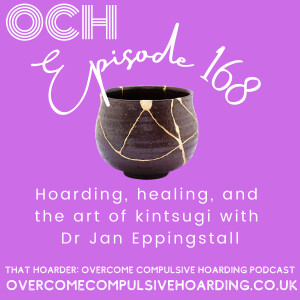
Friday Dec 06, 2024
Friday Dec 06, 2024
Get your 2025 decluttering inspiration calendar: http://www.overcomecompulsivehoarding.co.uk/2025
Come to a Dehoarding Accountability Zoom Session: http://www.overcomecompulsivehoarding.co.uk/ticket
Subscribe to the podcast: https://www.overcomecompulsivehoarding.co.uk/subscribe
Podcast show notes, links and transcript: https://www.overcomecompulsivehoarding.co.uk/podcast-ep-168-hoarding-healing-and-the-art-of-kintsugi-with-dr-jan-eppingstall-of-stuffology/
Today, I'm with Dr Jan Eppingstall, a Melbourne-based counsellor, about the fascinating art of kintsugi and how it connects with hoarding and trauma recovery. We explore how this Japanese tradition of mending broken pottery with gold has lessons for us about the therapeutic journey and the beauty in imperfection. We also discuss how these concepts apply to overcoming perfectionism in hoarding and highlight the empowering process of creating, destroying, and rebuilding.
Introduction to Kintsugi and Dr. Jan Eppingstall
Explanation of kintsugi as a Japanese art form of repairing objects with gold.
Kintsugi and the connection to recovery from trauma.
Kintsugi as a Metaphor for Healing
Importance of acknowledging the process of healing without oversimplification.
Reference to Amy Price's article about kintsugi symbolising care and time.
Discussion of Tomas Navarro's book and the importance of action in healing.
Psychological and Therapeutic Implications
Metaphor in therapy for expressing complex emotions.
Application of kintsugi philosophy in mental health contexts, including trauma recovery.
Relation to Acceptance and Commitment Therapy (ACT), acceptance, and resilience.
The real-life application of acceptance and self-compassion.
Creation, Destruction, and Rebuilding
Create, destroy and recreate art as part of personal healing.
Parallel with kintsugi in wabi sabi / finding beauty in imperfection.
Personal Empowerment and Resilience
Empowerment through courage and resilience using scars as a metaphor.
Resonance with Leonard Cohen
Idea of imperfection as a means for transformation.
Contrasts with Modern Consumerism
Kintsugi and wabi sabi's focus on the beauty of imperfection and impermanence.
Reference to Beth Kempton's book on creating serene, beautiful spaces.
Addressing Perfectionism and Hoarding
Application of kintsugi principles to address perfectionism in hoarding.
Exploration of creating, destroying, and rebuilding as a therapeutic exercise.
"Wreck This Journal" to overcome artistic perfectionism.

Friday Nov 29, 2024
Friday Nov 29, 2024
Get your 2025 decluttering inspiration calendar: http://www.overcomecompulsivehoarding.co.uk/2025
Come to a Dehoarding Accountability Zoom Session: http://www.overcomecompulsivehoarding.co.uk/ticket
Subscribe to the podcast: https://www.overcomecompulsivehoarding.co.uk/subscribe
Podcast show notes, links and transcript: http://www.overcomecompulsivehoarding.co.uk/
In this episode, I propose ten experiments to help customise your decluttering journey, focusing on individual preferences to uncover what strategies work best in your home. These experiments encourage a flexible approach to dehoarding. It's all about tailoring your methods to fit your style and your personality, ensuring that decluttering becomes a more intuitive and effective process.
Approaching Tasks as Experiments
Tasks viewed as experiments inspired by CBT
Reduction of perfectionist pressure
Emphasis on personal differences and no right or wrong answers
Testing different time slots for tasks
Effectiveness of beginning the day with decluttering
"Swallowing the frog" concept
Long-term goals vs. short-term goals for motivation
Experimentation and Adjusting Over Time
Periodic repetition of experiments to adapt to changes
Use of structured time frames and spontaneous urges to declutter
Experimenting with personal preferences for initiating action
Options such as music, TV, silence, social interaction, or media consumption
Use of podcast as motivational tool
Upbeat music playlist
Group accountability sessions via Zoom for shared motivation
Productivity based on to-do list specificity
Decluttering strategies: by space, type of item, or item within a space
Handling Difficult Categories
Approach to emotionally challenging items
Tailoring strategy based on personal readiness
Consistency in Dehoarding
Short daily durations vs. longer weekly sessions
Finding the best fit based on routine
Time Constraints
Setting strict vs. flexible schedules
Combination of structured and spontaneous efforts
Personalising Decluttering and Productivity Methods
Focus on individual preferences and method effectiveness

Friday Nov 22, 2024
Friday Nov 22, 2024
Get your 2025 decluttering inspiration calendar http://www.overcomecompulsivehoarding.co.uk/2025
Come to a Dehoarding Accountability Zoom Session: http://www.overcomecompulsivehoarding.co.uk/ticket
Subscribe to the podcast: https://www.overcomecompulsivehoarding.co.uk/subscribe
Podcast show notes, links and transcript: http://www.overcomecompulsivehoarding.co.uk/
In today's episode, I talk about the strategies I've been trying to address over-acquisition and manage my finances, from savings pots to practising 'just-in-time' shopping. I explain how these methods, alongside mindfully resisting impulse buys and more, are helping me reduce clutter.
Personal Financial Management
Dedicated accounts with savings pots for various expenses like glasses, car repairs, and gifts.
Spending limits.
Evaluating the necessity of purchases.
Reflecting on past financial struggles.
The tendency to overprepare due to fear of scarcity.
The impact of hoarding on life, such as emotional pain from bereavements.
The challenge of trusting that resources will be available when needed.
Shopping Habits and Strategies
Emphasising rationality in shopping.
The "just in time" shopping approach to combat over-acquiring.
Mindful shopping techniques
Checking existing supplies before shopping.
Using shopping lists with flexible categories.
Resisting urge-driven purchases like discounts.
Mindful Financial Practices
Exploring alternative uses for money beyond impulse buys.
Prioritising spending on quality experiences.
Past Financial Hardship and Emotional Impact
Past experiences of financial hardship leading to anxiety and hoarding.
Reflecting on the emotional impact from periods like the COVID-19 pandemic.
Personal Growth and Overcoming Beliefs
Encouragement to try despite potential failures.

Friday Nov 15, 2024
Friday Nov 15, 2024
Get your 2025 decluttering calendar: http://www.overcomecompulsivehoarding.co.uk/2025
Come to a Dehoarding Accountability Zoom Session: http://www.overcomecompulsivehoarding.co.uk/ticket
Subscribe to the podcast: https://www.overcomecompulsivehoarding.co.uk/subscribe
Podcast show notes, links and transcript: http://www.overcomecompulsivehoarding.co.uk/
Avoiding the chaos of complex idea capture systems is vital for preventing distraction and overwhelm. Today, I'm sharing practical strategies for transitioning from idea capture to action, breaking down large tasks into manageable subtasks and exploring tools like Google Tasks and voice assistants for prioritisation and organisation. Plus, I reflect on my own long-term struggle with to-do lists and how to experiment with different approaches to find a system that suits your needs.
Simplifying Idea Capture
Avoid complex systems to prevent distraction and overwhelm.
Focus on simple, streamlined methods for capturing ideas.
Set dedicated idea capture times to minimise distractions.
Organising Idea Capture Materials
Ensure materials and tools are easily accessible.
Utilise technology for effortless idea capture using voice assistants.
Transitioning from Idea Capture to Action
Prioritise tasks based on urgency, impact, or personal goals.
Structure and prioritise tasks.
Break down large tasks into smaller, manageable subtasks.
Combining Digital and Non-Digital Methods
Use written to-do lists to complement digital systems for immediate tasks.
Essential Elements for an Effective System
Thinker's Notebook's five elements: omnipresence, efficiency, organisation, security, and offline thinking.
Exploring Digital and Non-Digital Tools
Popular digital tools: Evernote, OneNote, ToodleDo, Todoist, Trello, Taiga.io, Google Calendar, Outlook Calendar, Google Tasks.
Non-digital methods: scraps of paper, notebooks, preprinted planners, bullet journals, mind maps.
Personalising the Capture Method
Importance of selecting a method suited to personal preferences and technical comfort level.
Experimentation with different approaches.
Two-Step Strategy for Idea Capture
Combine digital or portable capture methods with comprehensive home organisation tools.
Mind Mapping for Subtasks
Use mind maps to break down tasks, providing a visual representation.
Realistic Time Management
Decide on timings based on deadlines and personal flexibility.
Visual Task Management
Track progress and prioritise tasks using visual tools like checklists or kanban boards.
Prioritisation and Breaking Down Tasks
Organise tasks by priority for easier management.
Divide large tasks into smaller parts for simplification.
Timely Task Execution
Be realistic about time required for tasks and accommodate flexibility.
Psychological Boost from Completion
Mark tasks as completed for a dopamine boost and visual progress tracking.
Adapting Idea Capture Systems
Experiment with various methods to find an effective system that suits personal needs and goals.
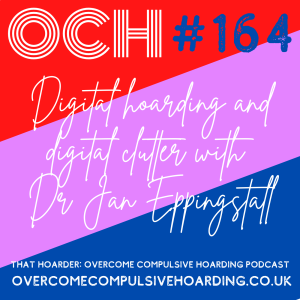
Friday Nov 08, 2024
Friday Nov 08, 2024
Come to a Dehoarding Accountability Zoom Session: http://www.overcomecompulsivehoarding.co.uk/ticket
Subscribe to the podcast: https://www.overcomecompulsivehoarding.co.uk/subscribe
Podcast show notes, links and transcript: http://www.overcomecompulsivehoarding.co.uk/
In this episode, I'm joined by Dr Jan Eppingstall, a counsellor with a PhD in hoarding, to discuss the phenomenon of digital hoarding, where people accumulate excessive digital items.
We'll explore the emotional responses to losing digital content, the organisational and environmental implications of digital clutter, and strategies for managing our ever-growing digital lives.
From the nostalgic pull of old photos to the overwhelming influx of emails, this conversation reveals the surprising similarities between physical and digital hoarding.
Introduction to Digital Hoarding
Definition of digital hoarding
Comparison with physical hoarding, highlighting similar stress, anxiety, and attachment.
Emotional Responses to Digital Loss
Non-hoarders experiencing emotions like anger and anxiety over losing digital items.
Technological Advancements and Digital Storage
The proliferation of digital content creation, especially digital photos.
Impact of technology on creating and storing digital content.
Historical context of storage limitations versus current capabilities.
Broader Implications of Digital Hoarding
Extending beyond photos and videos to emails, subscriptions, and digital accounts.
Cybersecurity risks and financial costs associated with digital hoarding.
Reasons we retain digital content.
Emotional Attachment and Digital Data
Emotional ties to digital items like photos and documents.
Reflecting identity and memory triggers in digital possessions.
Digital Organisation Strategies
Host's impeccably organised digital life contrasted with a cluttered home.
Tiago Forte's PARA method for prioritising digital items.
Inbox Zero and maintaining an organised email setup.
Challenges of Digital Clutter
Volume over efficiency: issues accessing necessary information despite organised files.
Parallels between digital and physical hoarding behaviours.
Digital Inefficiency and Environmental Impact
Wasted time, reduced focus, and productivity issues due to digital clutter.
Significant carbon footprint of data centres and environmental concerns.
Strategies for Managing Digital Clutter
Reducing digital intake by unsubscribing from unnecessary emails and content.
Advice on stopping excessive bookmarking and managing browser tabs.
Importance of setting up email filters to streamline email management.
Creating physical keepsakes from special digital photos for meaningful interaction.
Permission Slip Segment
Discussion on evaluating difficult-to-discard items for sentimental or practical reasons.
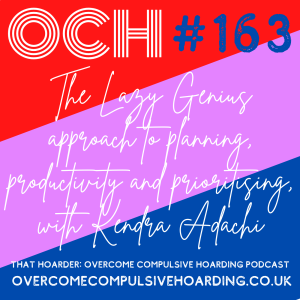
Friday Nov 01, 2024
Friday Nov 01, 2024
Come to a Dehoarding Accountability Zoom Session: http://www.overcomecompulsivehoarding.co.uk/ticket
Subscribe to the podcast: https://www.overcomecompulsivehoarding.co.uk/subscribe
Podcast show notes, links and transcript: http://www.overcomecompulsivehoarding.co.uk/
In today's episode of That Hoarder: Overcome Compulsive Hoarding podcast, I'm joined by Kendra Adachi, author of "The Plan, Manage Your Time Like a Lazy Genius," as we explore self-compassion and realistic productivity. We'll discuss cultural differences in self-trust, the pitfalls of traditional planning, and how small, manageable steps can lead to meaningful progress. Kendra's insights challenge societal expectations and underscore the importance of kindness and contentment in our daily lives.
Self-Trust and Societal Influences
Cultural differences in self-trust between men and women
Women's challenges with self-trust
Understanding systemic influences
Encouragement of kindness and acceptance towards oneself
Societal Expectations and Productivity Pressure
Critique of the "hustle" culture and pressure for excellence
Contentment as opposed to constant optimisation
Kindness to oneself as an alternative to relentless improvement
Resistance to the idea of contentment
Contentment and Self-Compassion
Contentment not the same as giving up
Defining contentment as awareness and appreciation of the present
Self-compassion as a holistic life perspective
Contentment and making mistakes
Hoarding and Mindset Shifts
Problem with future-focused thinking
Importance of prioritising what matters to us
Shifting mindset towards valuing fewer things and creating space
Kinder approach to oneself and questioning what we have lose by trying contentment
Integration vs. Greatness
Embracing integration over achieving greatness
Honouring emotions and practicing self-kindness
Goal setting challenges and adopting flexible approaches
Shrinking priorities to manage overwhelm
Planning and Productivity Challenges
Discussion on why many struggle with planning and productivity
Unrealistic expectations from productivity experts
Internalisation of failure for unmet expectations
Disparity in authorship vs. readership of time management books
The Lazy Genius Way and Practical Strategies
Introduction to concepts from "The Lazy Genius Way"
Principles of "going in the right order" (naming what matters, calming the chaos, trusting oneself)
Encouragement of smaller, manageable steps
Potential for meaningful change despite societal pressures
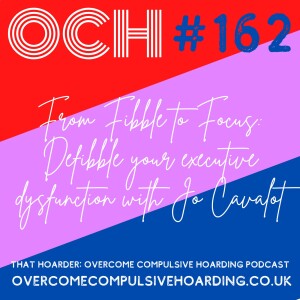
Friday Oct 25, 2024
Friday Oct 25, 2024
Come to a Dehoarding Accountability Zoom Session: http://www.overcomecompulsivehoarding.co.uk/ticket
Subscribe to the podcast: https://www.overcomecompulsivehoarding.co.uk/subscribe
Podcast show notes, links and transcript: http://www.overcomecompulsivehoarding.co.uk/
In today's episode, I chat with Jo Cavalot, a compassionate inquiry practitioner and coach, about tackling executive dysfunction through a unique concept called "fibble", designed to help those struggling with focus and organisation. Jo shares her insights into treating internal parts with kindness, her own journey of recovery, and how she co-created Fibble as a tool to understand and manage executive function challenges. We explore the importance of personalised support in overcoming obstacles, and Jo offers a special discount for listeners interested in her work.
Importance of a compassionate approach
Internal family systems and parts work.
Viewing internal parts as friends with individual needs.
Differentiating exploratory sessions from physical organisation tasks.
Executive Dysfunction and 'Fibble' Concept
Challenges of executive dysfunction, specifically among people who hoard.
Use of the 'fibble' acronym: Frustrated, Inadequate, Baffled, Befuddled, Lacking, and Exhausted.
Fibble as a practical tool
Jo Cavalot's experience with alcoholism
Parallel between Jo's alcohol experience and hoarding.
Emotional challenges and non-linear nature of recovery.
Emphasis on self-awareness and self-compassion.
Jo's significant life changes, like moving to Spain and involvement in the Camino de Santiago.
Motivation through personal recovery and organisational skills.
Involvement and motivation in Hoarding Disorders UK.
Compassionate Inquiry, Based on Dr. Gabor Mate's work, focusing on trauma's impact.
Positive impacts on clients with hoarding behaviours and related trauma.
Key Challenges and Strengths in Addressing Organisation
Common challenges: sustained attention, organisation, self-activation, planning, and prioritising.
Creative problem-solving as a strength.
Flexible thinking and stress tolerance.
Use of a questionnaire assessing executive functioning across environments.
Understanding and leveraging diverse personal strengths.
Varying self-activation for personal vs. others' tasks.
Goal Setting and Personalisation
Personalised tools over generic advice.
Introduction of the Ikigai concept in goal setting.
Use of the fibble questionnaire for personal assessment and support.
Understanding and Addressing Underlying Causes
Identifying trauma responses and underlying causes.
Adjusting expectations based on life circumstances.
Holistic and trauma-informed support for personal challenges.
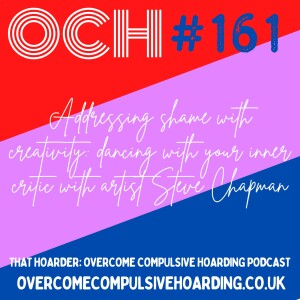
Friday Oct 18, 2024
Friday Oct 18, 2024
Come to a Dehoarding Accountability Zoom Session: http://www.overcomecompulsivehoarding.co.uk/ticket
Subscribe to the podcast: https://www.overcomecompulsivehoarding.co.uk/subscribe
Podcast show notes, links and transcript: http://www.overcomecompulsivehoarding.co.uk/
In this episode, I’m joined by Steve Chapman, an artist and coach, to talk about working creatively with your inner critic. We talk about understanding this inner voice as a misguided protector rather than an enemy and explore creative approaches like drawing or dancing with your critic to better engage with it. However sceptical you may be about it, listen to us talk about finding compassion for that voice in your head and how art can be a therapeutic ally in your journey. Even if, like me, you cannot draw!
Steve Chapman: artist, writer, speaker, coach, with a background in Gestalt psychology, improv theatre, coaching, and art therapy.
Discussion on creativity, imperfection, being stuck, shame, and the inner critic.
Struggles with a harsh inner critic for years.
Perspective shift influenced by the song "Hi Ren"
Insights on the Inner Critic
Inner critics act as misguided protectors from early childhood.
An approach to understand inner critics rather than fight them.
Creative Approach to the Inner Critic
Drawing or creative engagement to externalise and personify the inner critic.
Small creative experiments to better understand the inner critic.
The therapeutic nature of experimenting with art.
Inner Critic & Self-Compassion
Developing a compassionate relationship with the inner critic.
Thich Nhat Hanh on nurturing inner energy.
Dealing with worry through acceptance and self-compassion.
Art as a method to engage with emotions and inner critic
Resonates with others and serves as a therapeutic tool.
Shame & Vulnerability
Shame thrives in secrecy; exposing it diminishes its power.
Importance of bringing shame to light as discussed by Brene Brown.
Comfort and Discomfort
Finding a balance between comfort and distress.
Advocates for taking small steps toward addressing discomfort.
Discussing mental health openly demonstrates personal growth and reduced stigma.
Working with different materials for creative exploration.
Workshops begin without set goals to allow creativity to flourish.
Dealing with Inner Critics
Awareness of inner critics as part of being human and lifelong process.
Engaging with the inner critic in a playful rather than adversarial way.
Therapeutic Work and Community Support
Value of in-depth therapeutic work and community support in managing inner critique.
Artistic Abilities and Perceptions
Societal pressures influence perception of artistic ability.
Chapman aims to inspire and counter feelings of inadequacy.
Role of Continuous Exploration in Art
Art viewed as an ongoing process rather than a definitive product.
Tuning into emotions and body sensations beyond verbal communication.

Friday Oct 11, 2024
Friday Oct 11, 2024
Come to a Dehoarding Accountability Zoom Session: http://www.overcomecompulsivehoarding.co.uk/ticket
Subscribe to the podcast: https://www.overcomecompulsivehoarding.co.uk/subscribe
Podcast show notes, links and transcript: http://www.overcomecompulsivehoarding.co.uk/
In this episode, I explore how the change of seasons can inspire and motivate dehoarding efforts, with autumn in the northern hemisphere and spring in the southern hemisphere being upon us. Drawing on traditions like harvest festivals and spring cleaning, we'll discuss how nature’s rhythms can support our journey toward a more organised home. Plus, personal insights on managing the emotional challenges of letting go and tips for embracing seasonal transitions as opportunities for growth.
Seasonal Influence on Dehoarding
Autumn Motivation
Mixed feelings: beauty vs. precursor to winter
Harvest festivals: gratitude and inspiration for giving and decluttering
Nesting instincts as a motivational tool for organizing
Spring Motivation
Symbolism of renewal and hope
Growth and change as motivators for overcoming hoarding disorder
Spring cleaning tradition as an opportunity for new beginnings
Emotional Aspects of Decluttering
Acknowledge and understand feelings like overwhelm, anxiety, confusion, and fear
Use emotions to gain self-insight and understand attachment to items
Seek support from therapists, friends, family, or professional organisers
Practical Steps for Dehoarding
Assess possessions when transitioning between seasons
Evaluate practical use of items like blankets and coats
Decluttering inspired by seasonal changes
Focus on small areas to avoid overwhelm
Small, consistent changes over dramatic ones
Set realistic goals for home improvements by New Year
Community and Support
Engage in dehoarding accountability sessions for communal support
Donating items to reduce unnecessary storage
Assess what you want for your home as the year end approaches
Aiming for improvement, maintenance, or worsened state?
Set intentions
Walking, observing nature, and journaling
Creating Rituals and Redefining Comfort
Suggest creating rituals in tune with seasonal changes to aid decluttering
Redefine comfort by reducing clutter rather than accumulating more
Highlight the importance of a comfortable, decluttered space for winter
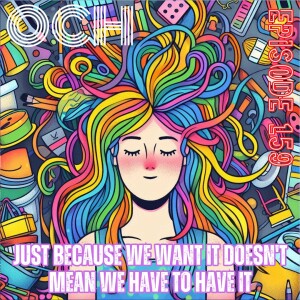
Friday Oct 04, 2024
Friday Oct 04, 2024
Come to a Dehoarding Accountability Zoom Session: http://www.overcomecompulsivehoarding.co.uk/ticket
Subscribe to the podcast: https://www.overcomecompulsivehoarding.co.uk/subscribe
Podcast show notes, links and transcript: http://www.overcomecompulsivehoarding.co.uk/
On this episode, I share my experience from being a guest on Death, Sex & Money with Anna Sale. Then I dig into the idea of wanting things but still choosing not to have them and how it applies to various aspects of life, especially for those of us dealing with hoarding disorder. I’ll discuss how the disorder can distort our perception of items, leading to irrational attachments. I look at how desires often change over time, the unhealthy attachments formed for identity, comfort, or security, and how fear of regret can hinder the decluttering process.
Choosing Not to Have Desired Items
Distortion of item perception in hoarding disorder
Temporary nature of desires
Safety and clutter concerns
Emotional and Irrational Attachments
Understanding and challenging emotional attachments
Exploring reasons for keeping or acquiring items
Addressing “irrational” beliefs
Dealing with fear of regret
Joy from finding things often surpasses regret (Jasmine Sleigh's insight)
Managing regret is possible
Decision-making with clutter in mind
Not Retaining Items for Others
It's not our responsibility to keep items for others
Prioritising personal and familial well-being
Setting boundaries regarding others' potential desires
Feeling loss, fear, sadness, and nostalgia
Acknowledgment and validation of these feelings
Communicating fears and emotions
Recognising and challenging irrational thoughts and feelings
Celebrating small victories without adding more clutter
Liberation and freedom from letting go
Misinterpreting laziness as anxiety
Anxious sloth and decreased productivity









